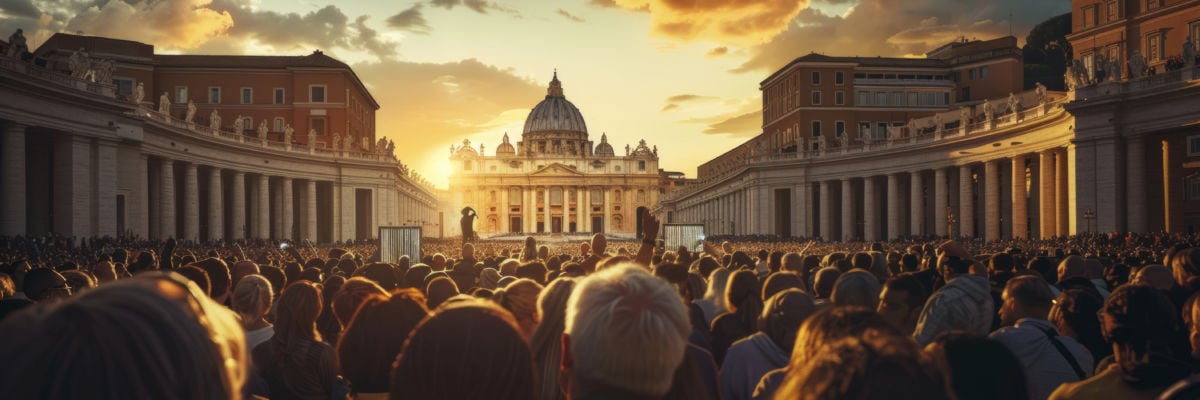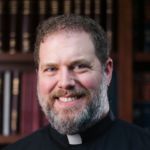
“I do not pray for these only, but also for those who believe in me through their word, that they may all be one.”
Almost exactly thirty years ago this week, in his encyclical Ut Unum Sint, Pope St. John Paul II taught, “To believe in Christ means to desire unity; to desire unity means to desire the Church; to desire the Church means to desire the communion of grace which corresponds to the Father’s plan from all eternity. Such is the meaning of Christ’s prayer: Ut unum sint” (9). “May they all be one.”
As the Holy Father reminds us in his encyclical, Christian unity is fundamentally oriented to Trinitarian unity. This is the plain meaning of the Lord’s words that we heard today in the “high priestly prayer” of John 17:
That they may all be one, as you, Father, are in me and I in you, that they also may be in us, that the world may believe that you sent me. And I have given them the glory you gave me, so that they may be one, as we are one, I in them and you in me, that they may be brought to perfection as one, that the world may know that you sent me, and that you loved them even as you loved me (vv. 20-23).
John Paul II again: “The faithful are one because, in the Spirit, they are in communion with the Son and, in him, share in his communion with the Father.” It is very much in this vein that our new holy father Pope Leo chose as his episcopal motto a line from St. Augustine of Hippo, In Illo uno unum, “In the one [that is, Christ] we are one.”
I for one appreciate the pope’s emphasis on unity in these first days of his pontificate. One of the first addresses he gave, within a week of his election, was to a group of Eastern Catholic Christians. He emphasized the enduring value of their unique perspective in the Catholic Church as distinct from that of the Latin West. I’m reminded of a line from Peter Kreeft’s comments on today’s gospel: “Unity is not unison but harmony, which is better.” Those of us in the Ordinariates, and indeed others who appreciate the variety of traditions even in the Latin Church, can give a hearty “amen” to that.
Despite the apparent connectivity of our world, or perhaps partly because of it, Christians have never been less “one” than at the present. There are by some counts tens of thousands of separated Christian groups and denominations in the world; even by a more cautious estimate there are several thousand. It’s often said that it’s easier to break something than to restore it; easier to wound than to heal; easier to divide than unify. That seems pretty clearly true when it comes to how quickly new Christian denominations are started. And we all know that even within the visible unity of the Catholic Church there are clear divisions. We all pray that these will be addressed and salved under the leadership of the new pope, but they have been festering for many years and are unlikely to go away soon.
That paints a rather dark picture, one somewhat at odds with the more optimistic tone struck by JPII thirty years ago, riding as he was the tide of post-Vatican II ecumenical enthusiasm. To be fair, Ut Unum Sint rightly celebrated a certain change of tone in dialogue that many of us can appreciate. Referencing the council’s decree on ecumenism, Unitatis Redintegratio, John Paul spoke of the way that the Church can remain firmly committed to dogma while at the same time making efforts to communicate that dogma, in a way, helps those outside the Church hear and understand. The Catechism of the Catholic Church, for example, was instrumental in my own understanding of Catholic teaching, precisely because of its sensitivity to modern questions and Protestant challenges. As much as I now can seem like a crusty traditionalist happy to quote the anathemas of the Council of Trent, when I was a Protestant I would never have responded any of that. To have the Church recognize that I was already trying to follow Jesus, but to invite me to do so more deeply, in communion with the apostolic tradition, was a great gift.
At the same time, I think the ecumenical optimism that remained in the 1990s has now largely faded, partly because most professional ecumenists have cheerfully ignored much of what JPII said about the necessity of Catholic teaching and the unity of truth and love. For John Paul, dialogue was a path to deeper understanding and communion. This path was meant to end in full communion, not to be just a thing that goes on forever on its own. At some point, there has to be a decision to walk together rather than apart, a recognition that when Christ calls us to unity in his Church I might actually have to do something, sacrifice something, for the sake of that good.
The very existence of the Ordinariates is controversial among many ecumenists because they dislike the idea that dialogue actually resulted in communion rather than just endless friendly agreements to disagree. But I think we are here in witness to the Church’s unity as well as the fact that its unity doesn’t have to mean that everybody is always the same.
The unity of the Church, as we saw at the beginning with JPII, is a witness to the unity of the Father and the Son. As an extension of that, the Lord himself tells us, the Church’s unity is her most powerful testament to the truth of the gospel. Of course, the unity of the Father and the Son, and the Lord’s death and resurrection, are true regardless of how we act. But the Church’s oneness and holiness make the truth shine that much more brightly, just as her disunity and sin obscure it.
At the very start of his encyclical, JPII speaks of the multiplication of martyrs in the twentieth century, including martyrs for Christ from various separated churches. “These brothers and sisters of ours,” he writes, “united in the selfless offering of their lives for the Kingdom of God, are the most powerful proof that every factor of division can be transcended and overcome in the total gift of self for the sake of the Gospel” (1). Our unity was purchased in blood, and it is at times witnessed again in the blood of the martyrs.
And so, let us never imagine then that unity is an easy thing. We know this, even if we are under little threat of martyrdom, because we know even the small costs. The cost of having to be polite to the fellow parishioner we don’t like. The cost of submission to a directive from Rome, or from our bishop or pastor, that we think is misguided. Perhaps even, for many of us over this last decade, the cost of communion with a pope who seemed to have a personal dislike for us.
At times, the dramatic martyrdoms of the early centuries—“Renounce Christ or die!”—can seem straightforwardly easy. Of course we would die for the Lord! Or so it is tempting to think. But do we dare to live for him, in unity with the people he loves, even when it is frustrating or confusing or painful? To ask that question every day is to learn to be a Christian.



